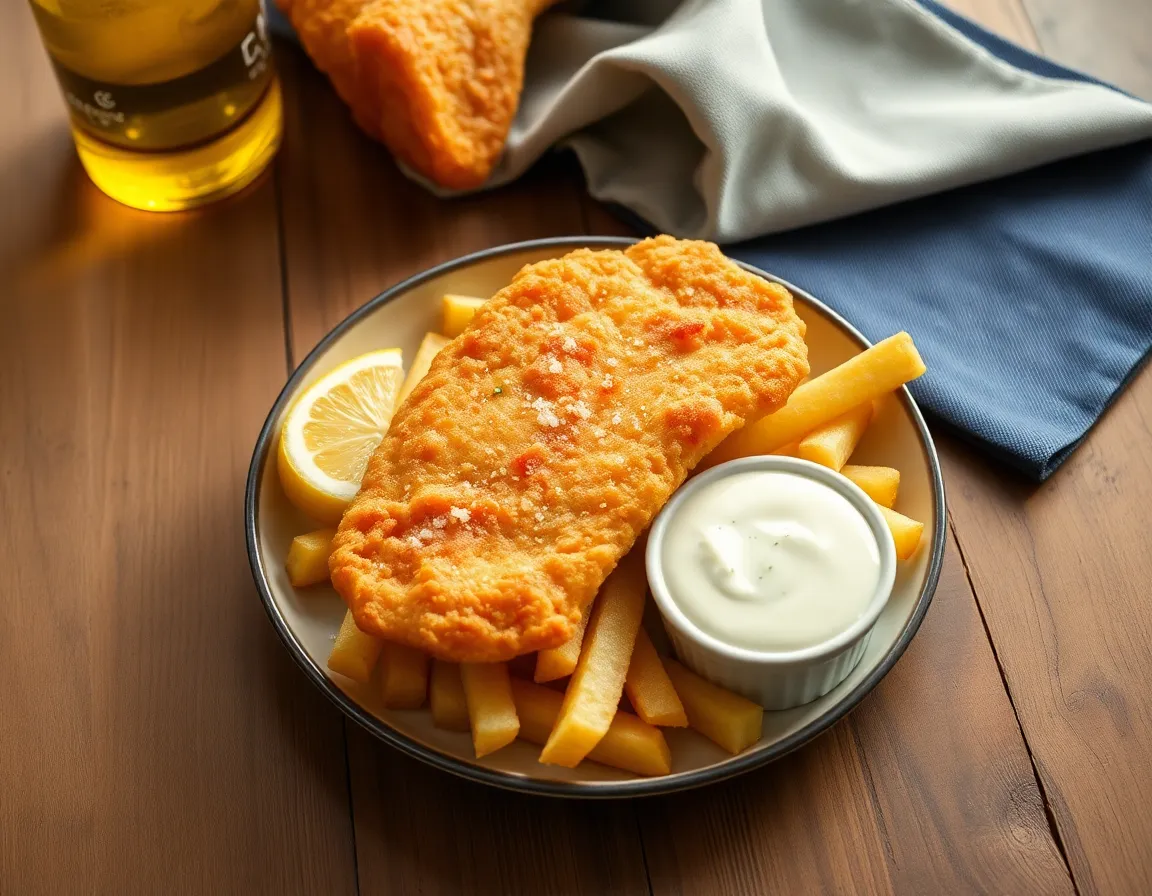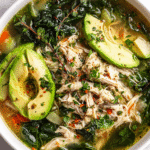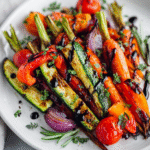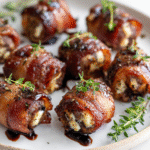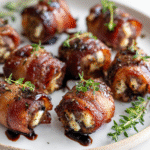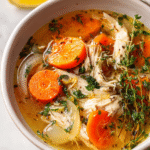Imagine the irresistible aroma of golden-brown batter as it crisps to perfection, encasing tender, flaky fish. Whether you’re a novice in the kitchen or a seasoned cook, this Fish and Chips recipe promises a delightful culinary journey right to your dinner table. The combination of light, crispy batter and perfectly seasoned fish creates a symphony of flavors that will transport you straight to the bustling seaside towns of England.
What makes this dish truly special is the harmonious blend of simple ingredients like fresh fish, a hint of lemon, and the subtle crunch of homemade chips. As you master the art of frying, you’ll find yourself surrounded by the comforting sounds of sizzling oil and the enticing smell of malt vinegar wafting through the air. With easy-to-follow steps, you’ll feel confident in crafting this classic dish, ensuring each bite is a delicious, satisfying reward.
About This fish and chips Recipe
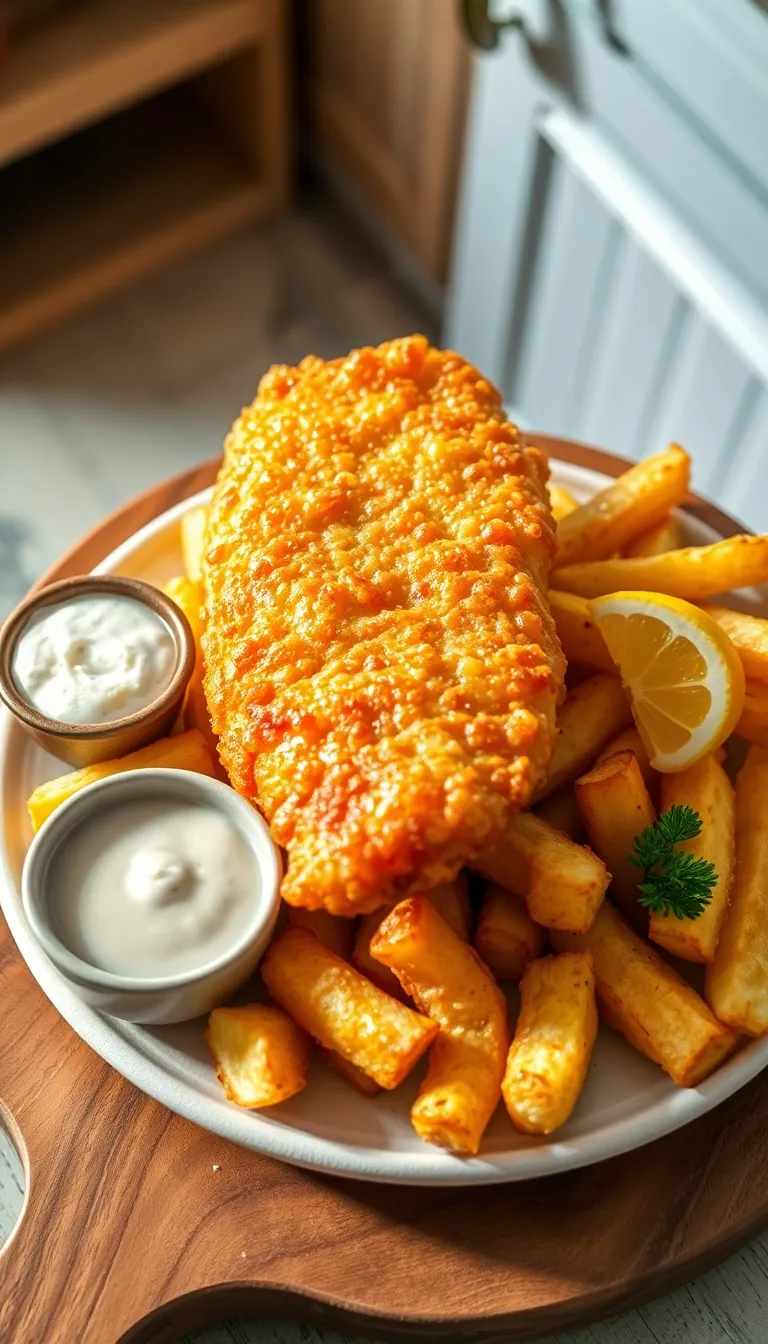
- Classic Crunch: This recipe delivers the perfect combination of a crispy, golden batter and tender fish, creating a delightful texture contrast in every bite.
- Quick and Easy: With simple steps and ingredients, you can whip up this traditional British favorite in under an hour, making it ideal for busy weeknights.
- Flavorful Twist: A hint of lemon zest and freshly ground black pepper in the batter elevates the flavor profile, adding a refreshing zing to each piece.
- Healthier Option: This recipe offers a baked version for those seeking a lighter alternative without sacrificing the beloved crunch.
- Versatile Pairing: Perfectly complements a variety of sides, from classic mushy peas to a modern slaw, making it easy to customize your meal.
- Family Favorite: Loved by both kids and adults, this dish is sure to become a go-to family meal that everyone will request time and again.
Why You’ll Love This Recipe
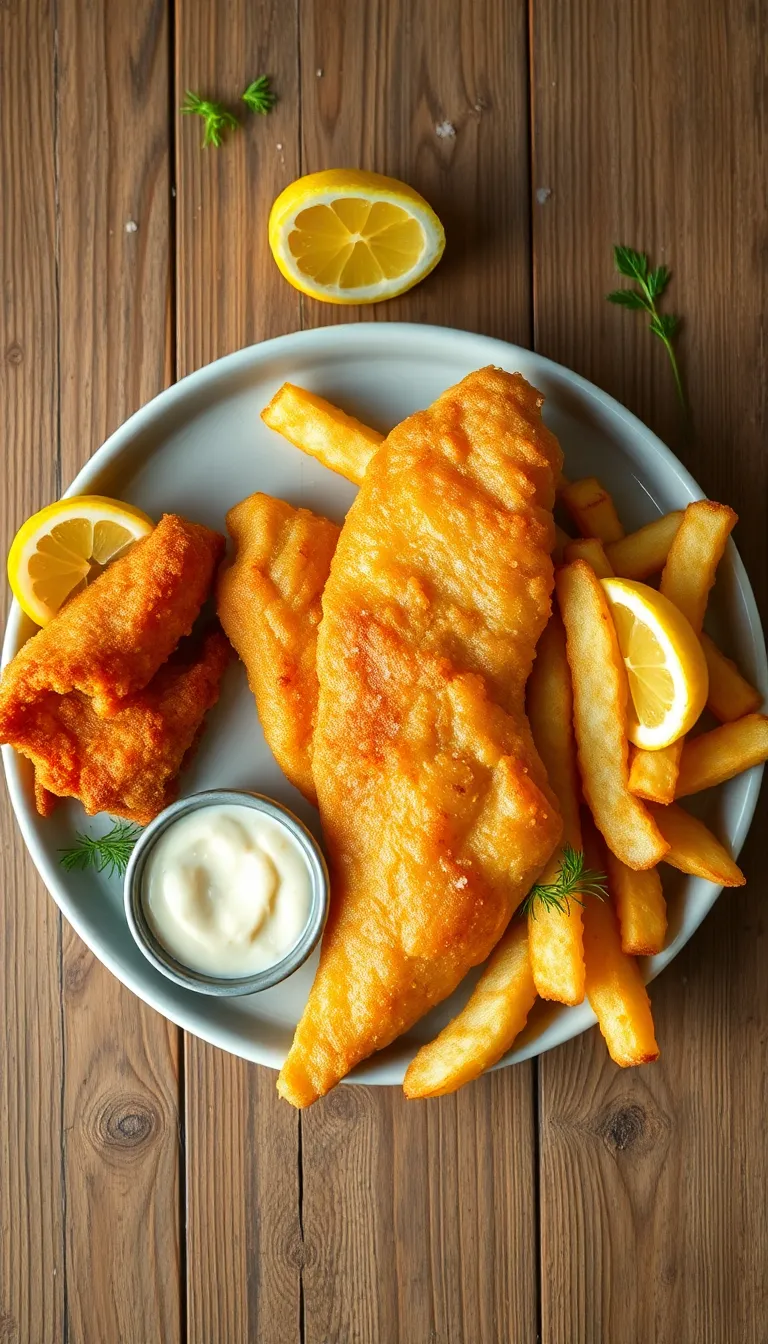
- Classic flavor with a twist: This fish and chips recipe combines traditional British flavors with a modern twist, ensuring a delightful taste in every bite.
- Crispy and light batter: The secret to this recipe is its perfectly crispy batter that remains light and airy, making the fish irresistibly crunchy.
- Quick and easy preparation: With straightforward steps and minimal preparation time, you can have this delicious meal ready in under 30 minutes.
- Healthier frying method: We use a special frying technique that reduces excess oil, resulting in a lighter and healthier dish without sacrificing flavor.
- Versatile and customizable: This recipe allows you to choose your favorite type of fish, making it adaptable to your personal taste preferences.
Ingredients
- 2 cups all-purpose flour
- 1 tablespoon baking powder
- 1 teaspoon salt
- 1 teaspoon paprika
- 1 cup cold sparkling water
(Sparkling water helps create a light, crispy batter. You can substitute with club soda if needed.)
- 1 egg, beaten
- 4 cod fillets
(Around 6 ounces each. Haddock or pollock can be used as substitutes.)
- 4 cups vegetable oil, for frying
(Canola or peanut oil are good alternatives due to their high smoke point.)
- 2 pounds russet potatoes, peeled and cut into thick strips
(Yukon Gold potatoes can be used for a creamier texture.)
- 1 teaspoon vinegar
(For soaking the potatoes—helps remove excess starch.)
- Salt, to taste
(For seasoning the cooked fish and chips.)
- 1 tablespoon chopped fresh parsley (optional)
(For garnish.)
- Lemon wedges (optional)
(For serving.)
- Tartar sauce (optional)
(For dipping.)
Kitchen Tools You’ll Need
- Cutting Board: Essential for preparing the fish and any garnishes. A sturdy surface will keep your prep safe and efficient.
- Chef’s Knife: Used for slicing the fish fillets and any additional ingredients. A sharp knife ensures clean cuts and ease of use.
- Mixing Bowls: Needed for making the batter and coating the fish. If you don’t have multiple bowls, an alternative is to use a large pot for mixing.
- Deep Fryer or Large Pot: Required for frying the fish and chips to crispy perfection. If you don’t have a deep fryer, a heavy-bottomed pot with oil will work well.
- Slotted Spoon or Spider Strainer: Useful for removing the fish and chips from the hot oil without bringing excess oil along. A metal spatula can be an alternative if used carefully.
- Paper Towels: Important for draining excess oil from the fish and chips after frying, ensuring they remain crispy.
- Thermometer: Helps to monitor the oil temperature to ensure even frying. If unavailable, test by dropping a small piece of batter to see if it sizzles immediately.
Preparation Steps
- Preheat your oven to 200°F (95°C) to keep the cooked fish and chips warm.
- Cut the potatoes into thick slices, about 1/2 inch wide, and soak them in cold water for 30 minutes to remove excess starch.
- Heat oil in a deep fryer or large pot to 350°F (175°C); ensure the oil is deep enough to fully submerge the fish and chips.
- Drain the potatoes and pat them dry with paper towels. Fry them in batches until lightly golden, about 3-4 minutes per batch. Remove and drain on paper towels.
- Mix flour, baking powder, and a pinch of salt in a bowl. Gradually add cold beer, whisking until smooth and thick enough to coat the back of a spoon.
- Dip each fish fillet into the batter, letting excess drip off, then carefully place it in the hot oil. Fry until golden brown and crispy, about 5-6 minutes. The fish should flake easily with a fork when done.
- Return the chips to the hot oil and fry again for 2-3 minutes until golden and crispy. Drain on paper towels and season with salt immediately.
- Keep the fried fish and chips warm in the preheated oven until ready to serve.
Serving Suggestions
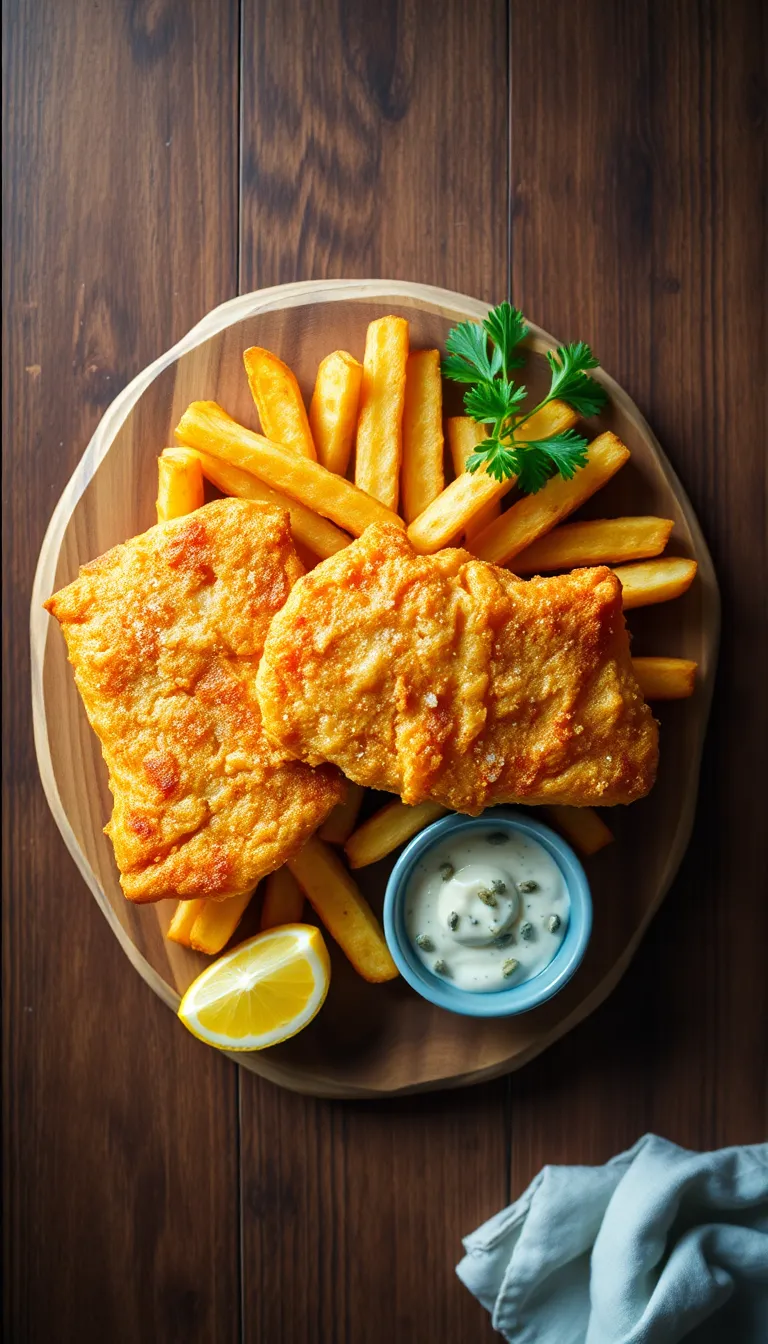
- Classic Tartare Sauce: Serve fish and chips with a side of tartare sauce for a traditional and creamy accompaniment. The tangy flavors of the sauce enhance the taste of the crispy fish.
- Lemon Wedges: Garnish your plate with fresh lemon wedges. A squeeze of lemon over the fish brightens the flavor and adds a refreshing citrus note.
- Mushy Peas: Pair with mushy peas for a classic British touch. The soft texture and mild flavor of the peas complement the crunchy fish and chips perfectly.
- Vinegar and Sea Salt: Offer malt vinegar and sea salt on the side. This traditional seasoning method brings out the natural flavors and adds a satisfying tang.
- Craft Beer: Enjoy with a chilled craft beer, like a pale ale or lager. The crisp and slightly bitter notes of the beer balance the richness of the fried fish.
- Coleslaw: Serve with a side of creamy coleslaw for a refreshing and crunchy contrast. The coleslaw adds a touch of sweetness and extra texture to the meal.
Pro Tips for Perfect Results
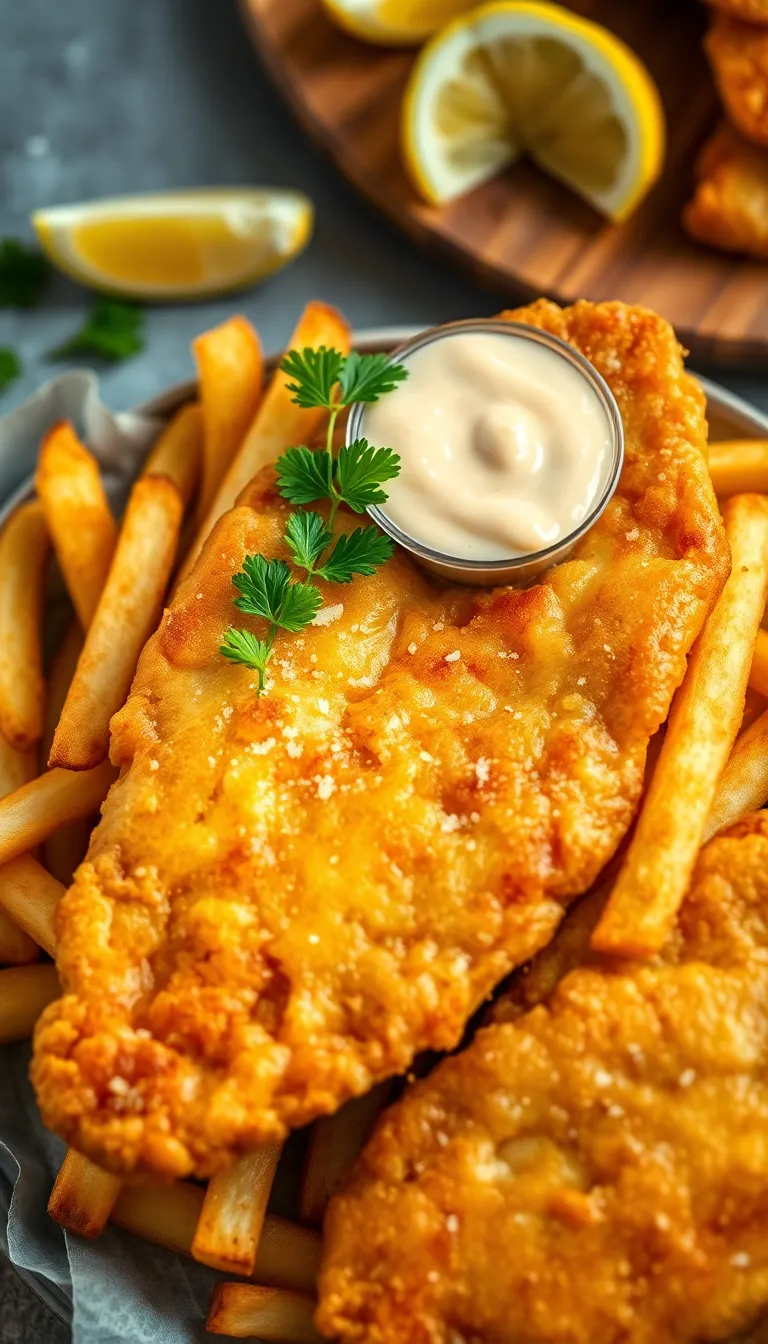
- Chill the Batter: For an extra crispy coating, chill your batter in the refrigerator for at least 30 minutes before dipping the fish. This helps the batter adhere better and fry up crispier.
- Use Rice Flour: Substitute a portion of regular flour with rice flour in your batter. Rice flour absorbs less oil, resulting in a lighter, crunchier crust.
- Dry the Fish Thoroughly: Pat the fish fillets dry with paper towels before dipping them in the batter. This prevents excess moisture from creating steam, which can make the coating soggy.
- Double Fry for Extra Crispiness: Fry the fish fillets twice. First, fry them at a lower temperature (around 325°F) to cook through, then increase the heat to 375°F and fry again briefly to achieve a golden, crispy exterior.
- Make-Ahead Tip: Prepare the chips ahead of time by parboiling them for a few minutes, then letting them cool. Store them in the fridge until ready to fry, which will help them cook evenly and turn out crispier.
- Chef’s Secret – Infused Oil: Infuse your frying oil with a few sprigs of fresh thyme or rosemary. This will subtly enhance the flavor of your fish and chips, making them even more aromatic and delicious.
Common Mistakes to Avoid
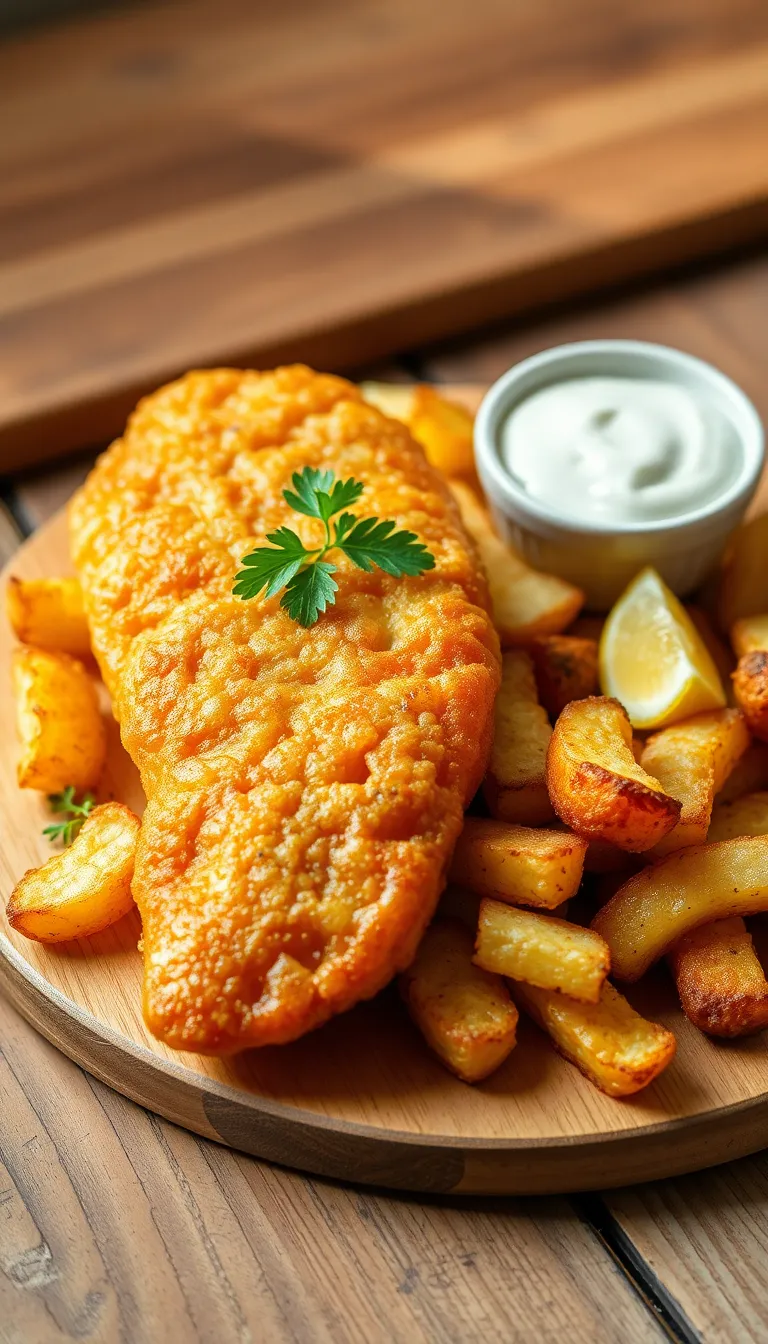
- Using Cold Oil: This is a common mistake that causes the batter to absorb too much oil, resulting in greasy fish. Always preheat the oil to the correct temperature (around 350°F or 175°C) before frying. Use a thermometer to ensure the oil maintains the right heat throughout the cooking process.
- Overcrowding the Fryer: Putting too many pieces of fish in the fryer at once lowers the oil temperature, leading to uneven cooking and soggy batter. Fry in small batches, allowing enough space for each piece to cook properly, and let the oil return to the correct temperature between batches.
- Not Drying the Fish Properly: Moisture on the fish prevents the batter from adhering properly, leading to a patchy coating. Pat the fish dry with paper towels before dipping it in the batter, ensuring a crispy and even finish.
- Incorrect Batter Consistency: Too thick or too thin batter can ruin the texture of the final dish. Aim for a consistency similar to heavy cream. If the batter is too thick, add a little more liquid. If it’s too thin, add more flour to achieve the right balance.
- Using the Wrong Type of Potato: Not all potatoes are suitable for chips. Waxy potatoes can become limp when fried. Use starchy varieties like Russets for crispy, golden chips. Cut them evenly and soak in cold water to remove excess starch and ensure the best texture.
Final Thoughts: Avoiding these common mistakes will greatly improve the quality of your fish and chips, resulting in a dish that’s crispy on the outside and tender on the inside. By focusing on technique and paying attention to details, you can ensure every batch is a success. Happy cooking!
Storage and Reheating Tips
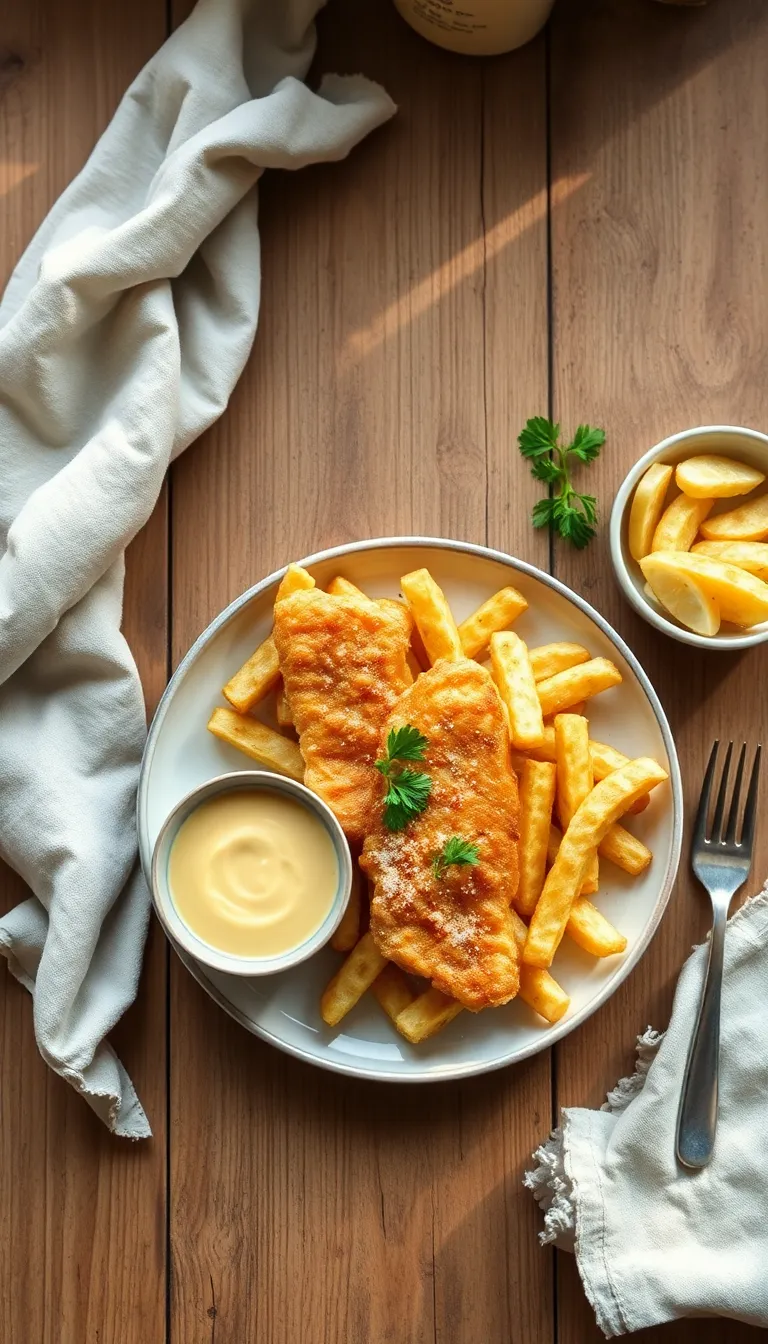
- Allow the fish and chips to cool down to room temperature before storing to prevent condensation, which can make them soggy.
- Store leftovers in an airtight container. For best results, place a paper towel at the bottom of the container to absorb excess moisture.
- Refrigerate the fish and chips for up to 2 days. Beyond this timeframe, the quality may deteriorate.
- Freezing instructions: To freeze, wrap each piece of fish separately in plastic wrap or aluminum foil, then place in a freezer-safe bag. Chips can be spread out on a baking sheet, frozen until solid, and then transferred to a freezer bag. Store for up to 1 month.
- For reheating, the oven is the preferred method to maintain crispiness. Preheat the oven to 375°F (190°C), place the fish and chips on a baking sheet, and heat for about 10-15 minutes or until warmed through.
- To reheat from frozen, add an extra 10 minutes to the oven reheating time.
- Avoid using the microwave for reheating, as it can make the fish and chips soggy.
- Food safety tip: Ensure the internal temperature of the fish reaches at least 145°F (63°C) when reheating to prevent foodborne illness.
Proper storage and careful reheating are key to enjoying your fish and chips leftovers. By following these tips, you can maintain the dish’s delicious texture and flavor, ensuring a satisfying meal every time.
Frequently Asked Questions
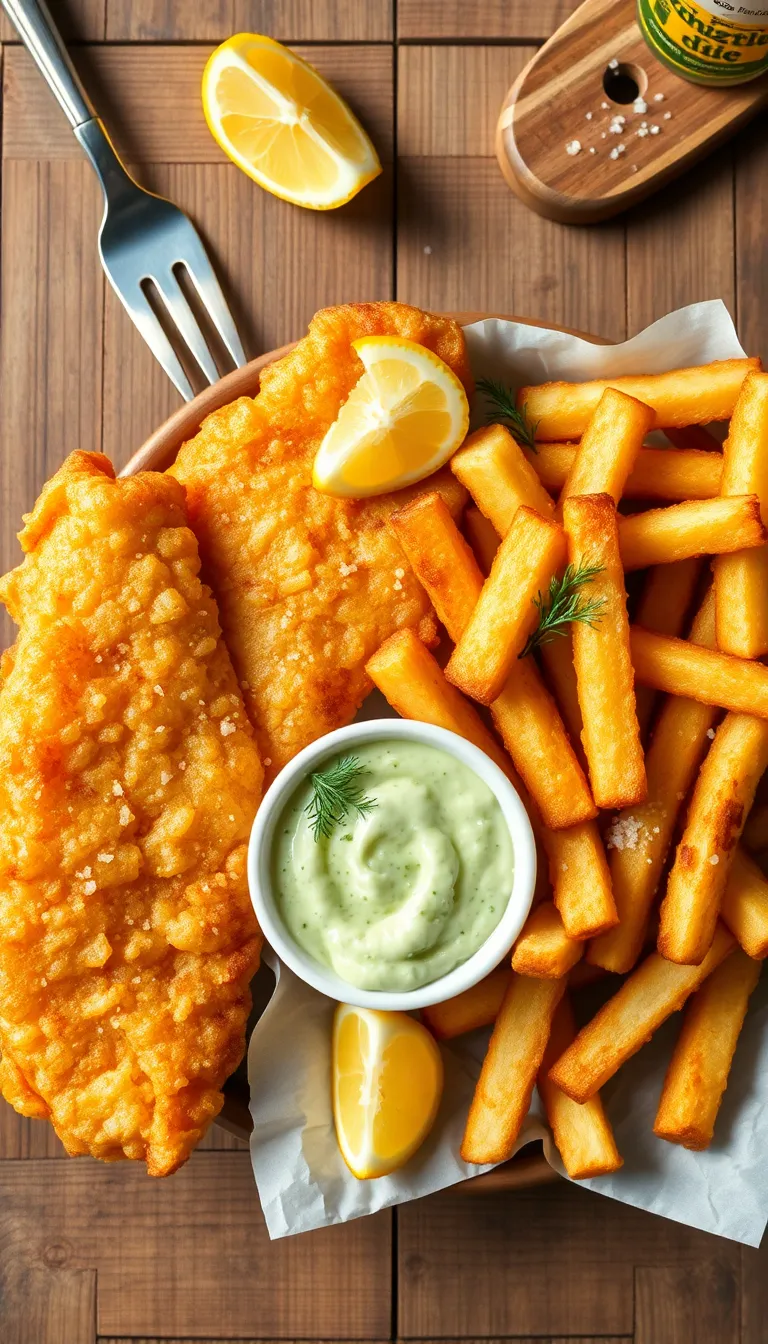
Frequently Asked Questions
Q: Can I use a different type of fish for this recipe?
- Yes, you can substitute with any firm white fish like haddock or pollock for a similar taste and texture.
Q: How can I make the batter extra crispy?
- Chill the batter in the refrigerator for 30 minutes before using to help it adhere better and fry up crispier.
Q: What oil is best for frying fish and chips?
- Vegetable oil or canola oil are great choices as they have a high smoke point and neutral flavor.
Q: How can I tell when the fish is done?
- The fish is done when it reaches an internal temperature of 145°F and flakes easily with a fork.
Q: Can I make the chips in an air fryer?
- Yes, you can air fry the chips at 400°F for about 15-20 minutes, shaking halfway through for even cooking.
Q: What can I do if the batter is too thick or too thin?
- If too thick, add a little more liquid (water or beer); if too thin, add a bit more flour to adjust the consistency.
Final Thoughts
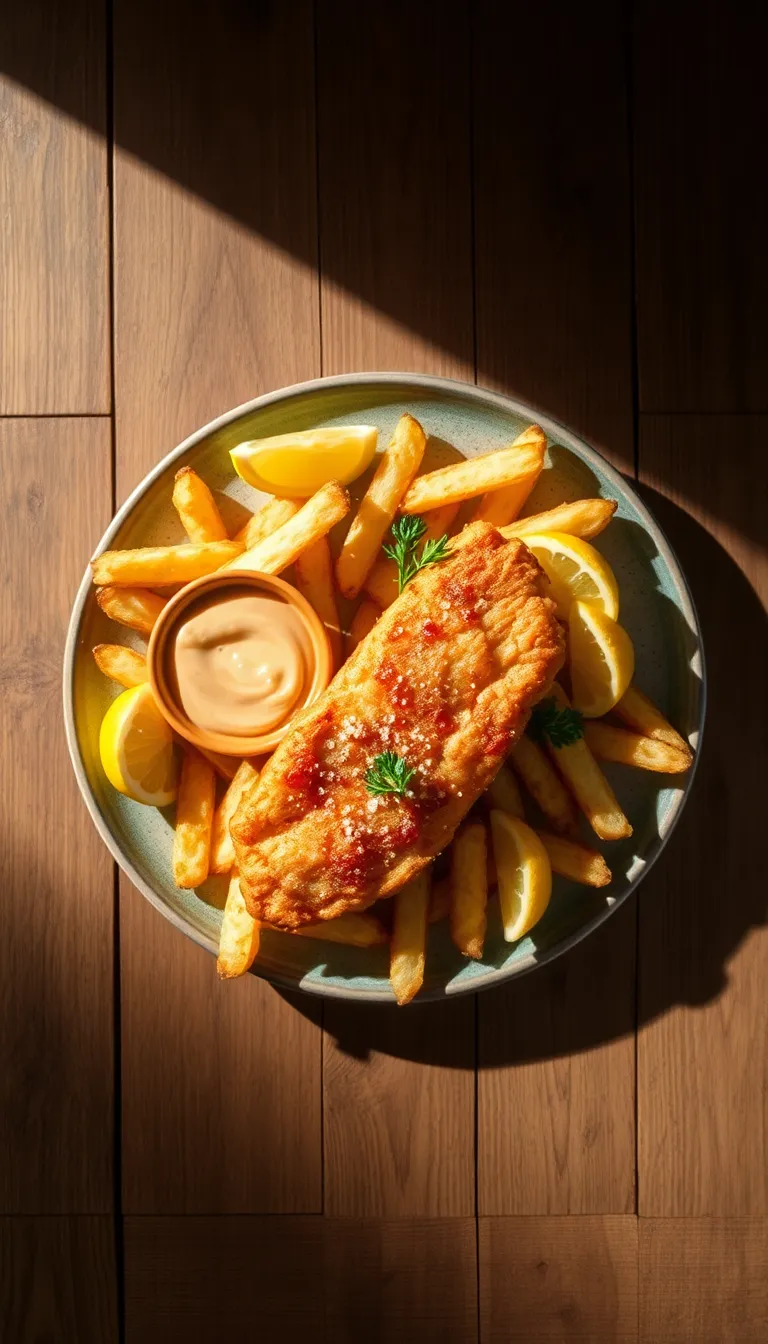
This Fish and Chips recipe captures the essence of a classic comfort dish, delivering crispy, golden-brown fish with perfectly cooked chips. The combination of flavorful batter and tender fish makes this a standout meal, perfect for any occasion. It’s a delightful experience that brings a taste of the seaside right to your home.
Feel free to experiment with different seasonings in the batter or try various dipping sauces to make this dish truly your own. Unleash your creativity and adapt the recipe to suit your taste preferences. Remember, the joy of cooking lies in making each dish a personal masterpiece.
We warmly invite you to try this delightful Fish and Chips recipe and experience the satisfaction of creating a restaurant-quality meal in your kitchen. Happy cooking!

I’m Jonny, the cook, writer, and food lover behind this flavorful corner of the internet. Whether it’s a sizzling weeknight stir-fry, a no-bake dessert that saves the day, or a comforting Sunday classic — this blog is where I share recipes that are bold, doable, and made to impress without the stress.

